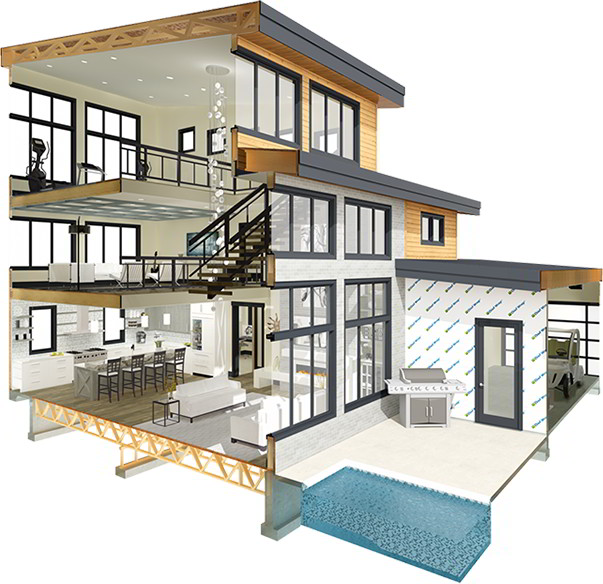Recognizing the Collaborative Process In Between Designers and Designers in Modern Building Projects
The collaborative procedure in between architects and designers is essential in modern building tasks, as it balances style intent with design feasibility. This partnership not just influences the visual and useful aspects of a project but also plays a critical function in addressing sustainability challenges. By employing reliable interaction approaches and leveraging innovative innovations, such as Building Information Modeling (BIM), teams can function more cohesively. The complexities of this collaboration often present special difficulties that can hinder progression. Checking out these characteristics reveals understandings that might substantially impact job results and total sector requirements. cda architects.
The Value of Cooperation
The collaborative synergy in between architects and engineers is essential for the successful realization of any type of building job. This partnership unites unique knowledge and viewpoints, making it possible for the integration of ingenious layout with useful engineering services. By interacting, architects and engineers can ensure that a task not only fulfills visual and practical needs however likewise abides by security, sustainability, and budgetary restraints.
Cooperation fosters a common vision, promoting the positioning of objectives and expectations from the start. This alignment is vital in resolving potential challenges and mitigating dangers that could occur throughout the project lifecycle. Additionally, a collaborative approach permits the effective appropriation of resources, optimizing both time and cost.
The importance of collaboration expands to the repetitive process of style and building and construction, where feedback from designers can inform architectural choices, resulting in even more viable and sustainable styles. On the other hand, designers can influence designers to believe creatively regarding just how to accomplish structural honesty without jeopardizing creative intent. Inevitably, the collective connection in between architects and engineers is not simply valuable; it is fundamental to the production of top notch, useful, and cutting-edge constructed environments that satisfy the needs of society.
Interaction Techniques and Devices
Reliable communication strategies and devices are vital for fostering cooperation in between engineers and engineers throughout the task lifecycle. Developing clear networks of communication is important to make sure that all employee are lined up with task purposes, timelines, and duties. Normal conferences, both in-person and digital, give chances for stakeholders to discuss progress, address problems, and make notified decisions.

In addition, embracing joint communication tools, such as Slack or Microsoft Teams, enables instantaneous messaging, file sharing, and recurring discussions, advertising an extra active action to arising issues. Document management systems also play a vital duty in organizing job paperwork, ensuring that all team members have accessibility to the most up to date info.
Shared Goals and Project Vision
A combined job vision functions as the structure for successful cooperation between architects and engineers (cda architects). This shared vision not just lines check this up the initiatives of both parties however also develops an usual framework for decision-making throughout the task's lifecycle. By verbalizing clear objectives, stakeholders can effectively browse the intricacies of contemporary building and construction projects, making sure that both aesthetic and practical demands are fulfilled
Establishing shared objectives involves open dialogue and an extensive understanding of each self-control's payments. Architects normally focus on layout intent, spatial connections, and user experience, while engineers stress architectural honesty, systems capability, and compliance with regulations. When these perspectives are lined up, the result is a natural task that abides by both innovative goals and technical usefulness.
Additionally, a distinct job vision promotes liability among employee, urging each participant to take possession of their role in accomplishing the desired result. Routine check-ins and collective workshops can further reinforce this commitment, enabling changes to be made as the job advances. Eventually, a common vision not just improves team effort but additionally elevates the quality of the last deliverable, bring about effective task completion.
The Function of Technology
Leveraging modern technology has actually ended up being vital in improving collaboration in between designers and engineers. why not try here Structure Info Modeling (BIM) stands out as an essential innovation, permitting both designers and designers to develop detailed 3D models that encapsulate style intent and structural integrity.
Furthermore, cloud-based platforms make it possible for smooth collaboration, allowing task stakeholders to access and upgrade job information from anywhere. This cultivates a society of transparency and responsibility, as adjustments can be tracked and reviewed in real-time. Furthermore, mobile applications additional improve interaction, offering on-site teams with instant accessibility to task specs and updates.
Emerging modern technologies such as synthetic intelligence and artificial intelligence are additionally beginning to play a role in predictive analysis, aiding groups determine potential concerns before they emerge. Inevitably, the function of technology in architecture-engineering partnership not only improves operations effectiveness yet additionally boosts development, causing more successful job results. By embracing these technological developments, engineers and designers can make certain a much more cohesive and productive collective procedure throughout the building and construction lifecycle.
Study in Successful Collaborations
Countless study show the extensive impact of efficient partnerships in between designers and engineers on job results. One significant example is the partnership on the High Line in New York City City, where landscape architects, designers, and metropolitan coordinators interacted to transform an abandoned railway into a dynamic public park. This multidisciplinary strategy not only boosted the visual high quality but additionally ensured architectural safety and environmental sustainability.

The Burj Khalifa in Dubai better demonstrates the value of joint efforts - cda architects. The integration of design and engineering competence enabled the task team to attain extraordinary elevations while sticking to safety and security regulations and aesthetic vision
These instances underscore the relevance of interaction, trust, and shared purposes. In today's complex building atmosphere, such partnerships are necessary to browsing obstacles and delivering jobs that meet both functional and visionary goals.
Final Thought
In conclusion, the collaboration in between designers and designers is necessary for the success of modern-day construction jobs. Reliable interaction techniques, a shared job vision, and the combination of sophisticated modern technologies are critical components that promote this partnership.